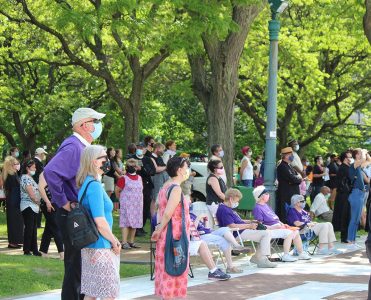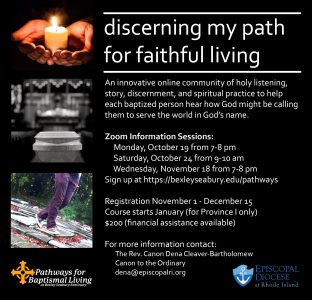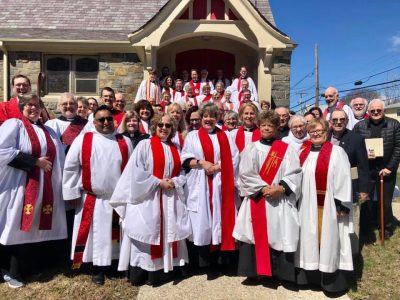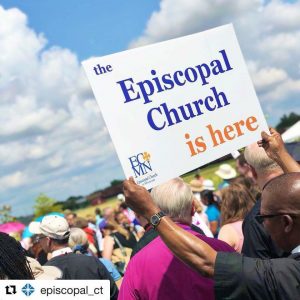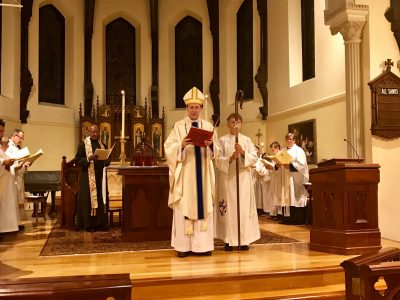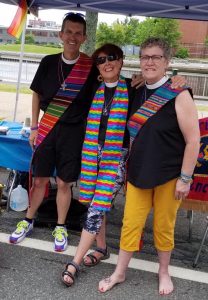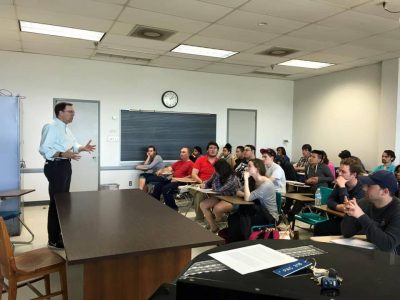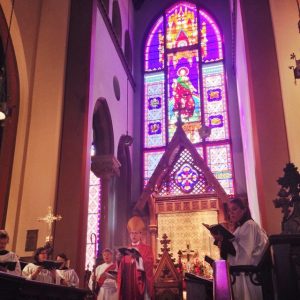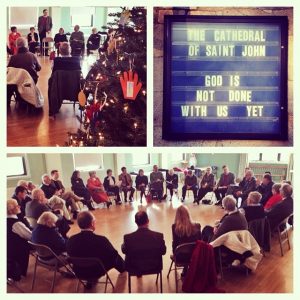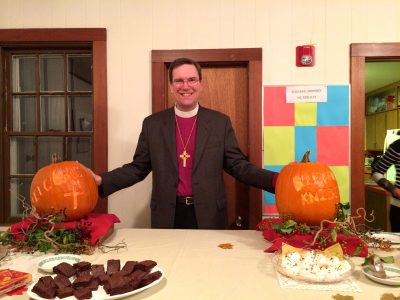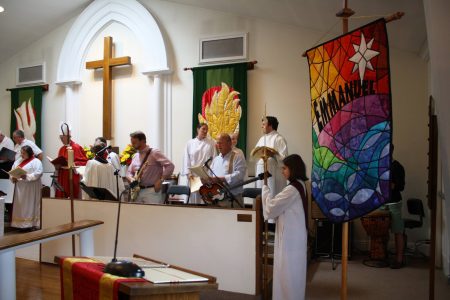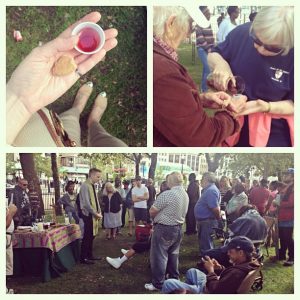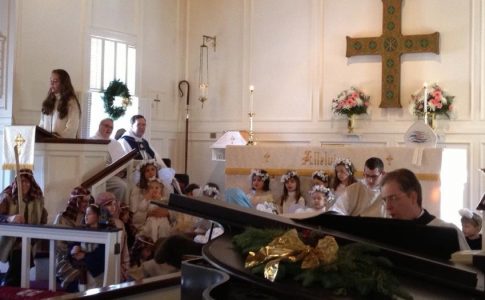The History of the Episcopal Church in Rhode Island
The State of Rhode Island
lRhode Island is the smallest state in the United States: forty-eight miles from north to south, and thirty-seven miles from east to west. Nevertheless, it is a state of considerable topographical diversity, from the island communities of Block Island and Aquidneck Island, to the fields and farms of South County, the urban areas in the north and the rural woodland areas in the western part of the state. Population density is the third highest of any state at 961 per square mile.
Rhode Island has a history of political independence. A year and a half before the Boston Tea Party, gunfire was exchanged between Rhode Islanders and the British during the storming of the British armed sloop Gaspee. Rhode Island actually declared independence from Great Britain two months before July, 1776. Rhode Island declined to ratify the United States Constitution until all other states had done so, largely due to the absence of a Bill of Rights in the original document.
Rhode Island traces its founding and its history of religious tolerance to Roger Williams. In 1636, Williams departed the Puritan Massachusetts Bay Colony to establish a colony on the shores of Narragansett Bay. Soon thereafter, the first Baptist church in America was established in Providence by dissidents from the Massachusetts Bay Colony. Congregationalists followed, as did Quakers and Methodists. A century later, at Newport, Jews would create the second synagogue in America; Touro Synagogue, which still stands. There George Washington uttered the famous words, “To bigotry no sanction, to persecution no assistance.”
Building an American Church
Episcopal worship in Rhode Island dates to 1635 with the arrival in what is now Cumberland of the Rev. William Blackstone, an Anglican priest from Boston. An itinerant preacher, Blackstone preached regularly to Indians and settlers in a field beneath the “Catholic Oak” in Lonsdale. He also traveled astride a large white bull from settlement to settlement, stopping to preach and administer the sacraments whenever requested to do so. Blackstone built no churches, however, and Anglicans in Rhode Island continued to rely on itinerant priests to minister to their needs for the remainder of the seventeenth century.
It was not until the beginning of the eighteenth century that the first Anglican Church was built in Rhode Island. In 1699, a small congregation in Newport petitioned Lord Bellemont, the Royal Governor of Massachusetts, to assist it in obtaining a permanent minister. The application was approved and Trinity Church was built in 1702. It was followed shortly by St. Paul’s in Narragansett (1707), St. Michael’s in Bristol (1720) and King’s Church, now St. John’s Cathedral, in Providence (1722).
Revolution
When the American Revolution began, Anglicans were accused of being disloyal to the American cause, regardless of whether they were Tory or Patriot. It was an inevitable charge, since England’s decision to send a bishop to the American Colonies was a significant factor in the rebellion.
The Revolution dealt a heavy blow to the Church of England and its four Rhode Island parishes. Much of the conflict was played out between clergy and parishioners. In Wickford, for instance, the majority of the congregation felt prayers for the king and royal family should be omitted from Sunday services. Samuel Fayerweather, the rector, remained true to his ordination oath of allegiance and Prayer Book rubrics. He refused to honor the request, and the church was closed. As the war progressed, the building became a barracks for Continental soldiers who were watching the British in occupied Newport.
The Rev. John Graves, rector of King’s Church in Providence for twenty years, also refused to omit the offending prayers and his church was closed as well. Feelings against him remained so strong that he was unable to resume his parish duties after the Revolution.
In 1778, St. Michael’s, Bristol, was burned. British gunboats entered Bristol harbor and bombarded the building thinking it was the Congregational Church, which held a store of gunpowder. Thus they destroyed the only church in town that still included Loyalists.
Trinity Church in Newport survived the occupation, but as a much reduced and deeply divided parish. For a time the building was occupied by a Baptist congregation.
Founding a Diocese
By 1789, America had three bishops who had traveled to Scotland and England to be consecrated. The organizing General Convention of the new Protestant Episcopal Church in the United States of America was held that year. Thus the Church of England in America became The Episcopal Church.
On November 18, 1790, the Rev. William Smith of Trinity Church, Newport, and the Rev. Moses Badger of St. John’s (formerly King’s Chapel), Providence, met in Newport with five laymen to organize the first Rhode Island Diocesan Convention. It was voted that “the Church of this State be immediately united under a Bishop.” Knowing they lacked sufficient funds and size to support their own bishop, it was further voted that, “the Right Rev’d Father in God Samuel Seabury, D.D., Bishop of Connecticut, be and is hereby declared Bishop of the Church in this State.” Seabury, the first bishop of the American Church and its second Presiding Bishop, accepted the charge, and served both Connecticut and Rhode Island as bishop until his death in 1796. In 1798, the Rhode Island Convention elected Edward Bass to succeed Bp. Seabury, serving also as Bishop of Massachusetts, where he lived and served.
The Nineteenth Century in Rhode Island
Nineteenth-century New England experienced economic prosperity and shared in the evangelical revival that transformed American Protestantism. During the tenure of Alexander Viets Griswold (1811-1843), the churches in Rhode Island were part of the Diocese of New England which included all of the states except Connecticut. The Diocese grew from 200 communicants in four parishes to almost 2,000 in seventeen parishes. Women activists enabled the church to round out its programs. For example, Martha Babcock in Westerly started a Sunday School with nine children, which eventually served two hundred young people.
The time of greatest Episcopal growth in Rhode Island, and in America generally, occurred between 1830 and 1875, spanning the years of Bishops Henshaw and Clark. During this period, the textile business became the leading industry and largest employer in the state. Immigration from England also reached its peak. Sometimes whole villages moved from Lancashire or Yorkshire to Rhode Island, bringing their Anglican heritage with them. Many parishes were founded to meet the religious needs of English immigrants working in the flourishing textile mills.
The final decades of the nineteenth century fulfilled the promise with which the century had begun. Villages barely settled prior to the Civil War became fast-growing suburbs of Providence, as railroads branched out from the city and tied an emerging metropolitan population together. Prosperity during the 1880’s and 1890’s provided the foundation for many additional parishes.
Women’s social outreach societies flourished as well. Early organizations like the Ladies’ Sewing Societies provided the sole financial support for the missionary endeavors of the Diocese. The Indian Aid Society was formed to give a “helping hand” to members of the Indian nations, at a time when the government policy was quite the opposite. The Women’s Auxiliary was formed in Rhode Island in 1877, and quickly became the focus for charitable outreach efforts throughout the Diocese and the world.
During this time the first three charitable institutions of the Diocese were founded: St. Mary’s Orphanage (1877), St. Elizabeth Home (1882), and St. Andrew’s School (1896).
The Diocese began its second century with thirty-five healthy parishes and many missions. Bishop Thomas March Clark, in a speech to the Diocesan Convention, reflected on the tremendous growth and change of the past hundred years. He said, “No man ought make his individual taste the standard by which the presumes to measure all his brethren. Innovation is not always improvement, but there can be no improvement without innovations. That which is more familiar to us was a novelty once, and that which is new to us will become familiar in the process of time.”
Into the Twentieth Century
By the turn of the century, the Episcopal Church had experienced a profound shift in self-understanding. Bishop McVickar reflected this change by expressing an active social conscience. Earlier evangelical focus saw the Church as a divinely appointed refuge offering salvation from a doomed world. The new vision offered salvation to the world and the people in it, and the Church’s work was expressed in social service.
Throughout the first third of the century, urban parishes continued to grow, doing more social work, and gathering congregations into even larger parish houses. Because people could easily travel by trolley and private car, going to the “downtown church” was fashionable. The great brick empires of Grace, All Saints’, St. John’s, and Messiah in Providence, St. Paul’s, Pawtucket, and St. George’s, Central Falls, swelled with a seemingly endless supply of parishioners.
Women’s ministries were increasingly recognized. Rhode Island ordained its first deaconess, Ida Jansen, in 1890, and by 1914 Bishop Perry reported to Convention that, “the number of Deaconesses at work in Rhode Island (has) grown in four years from one to seven. The fact is significant of the tendency, now fortunately growing, to claim the service of women in more definite official positions of Church ministrations than heretofore.”
Although the years between 1925 and 1935 have been characterized as a period of “religious depression” within the major Protestant denominations, Bishops Perry and Bennett continued to inspire new parishes.
John Seville Higgins became coadjutor of the Diocese in 1953, and served as diocesan bishop from 1955 to 1972. Under his administration the block of diocesan properties in downtown Providence, which includes the Edwards Homes, Hallworth House, and Diocesan House, came into being. Among Bishop Higgins’ many accomplishments was the establishment of Episcopal Charities. Under his episcopate many mission congregations were founded and the diocese started new campus ministries.
Both the country and the Church struggled with divisive issues during the 1970’s. Many Dioceses were torn apart by the issues of the ordination of women and the new Book of Common Prayer. Bishop Frederick H. Belden, through the force of his personality, was able to guide this Diocese safely through these contentious times. He supported the ordination of women, but insisted upon following due process until consensus was reached. In the fall of 1976, General Convention approved the ordination of women to the priesthood beginning January, 1977. Bishop Belden ordained Jo-Ann J. Drake as the first woman priest of the Diocese in 1978. Patricia A. Smith, who was ordered the first woman deacon (not the separate distinction deaconess) of the Diocese in 1976, became the first woman rector in Rhode Island when she was ordained a priest in 1980 and called to St. Matthew’s, Barrington.
The Rt. Rev. George Hunt served the Diocese as its 11th Bishop from 1980 to 1994. Bishop Hunt is perhaps best noted for his long struggle to call the state’s government to accountability, crusading fearlessly against corruption, organized crime, and gambling, and for his insistence that the process for ordination in the Diocese would not discriminate against anyone on the basis of gender or sexual orientation.
Geralyn Wolf was elected the 12th Bishop of Rhode Island and was the first female Bishop of RI, before that serving as the first female Dean of a Cathedral and one of the first woman ordained in the Episcopal Church. Bishop Wolf served the church during a time of retraction reflected in the closure or merger of fifteen churches during her tenure. The diocese focused on conservation of resources which resulted in a diocese with no debt and sufficient financial resources for the future.
W. Nicholas Knisely was elected the 13th Bishop of Rhode Island on June 2nd, 2012 and consecrated and ordained Bishop on November 17, 2012. His initial focus has been on children and youth, appointing a staff person to serve as the full-time director of the diocesan camp. He has also encouraged the growth and renewal of congregations. Under his leadership, the diocese has funded the restart of congregations and is starting specialized missions.
Two hundred years after its founding by the four colonial parishes, the Episcopal Diocese of Rhode Island had grown to sixty-five parishes with more than 25,000 communicants. It now stands at fifty-two congregations with over 15,000 communicants. Challenging issues have shifted from allegiance to the king, to developing social conscience, to the role of laity, people of color, women, lesbian, gay, bisexual, and transgendered people in the Church to the current focus on renewal and redevelopment. But the tradition of faith and service has prevailed, reflecting Rhode Island’s deep history of mission, which began 365 years ago with Parson Blackstone and his white bull.
A snapshot of the Diocese
Rhode Island is a “Yankee” state, which means people tend to be cautious about change, outspoken, fiscally conservative, and not trendy — willing to listen to new ideas, but not always eager to embrace them at first. New England has a heritage of congregationalism which has strongly influenced the Episcopal Church in this Diocese. Our parishes value their autonomy, yet the Diocese has a history of electing strong bishops.
Parish life in this Diocese may be more representative of the broad social and economic fabric than is typically the case in the Episcopal Church. We have people who have traditionally been at the top of the social scale, and we have the descendants of people who came from England to work in the textile mills. The Diocese has been enriched by many communicants who come via the U.S. Navy — persons stationed at Newport and Quonset. Even though the active Navy presence has diminished in recent years, many military personnel have chosen to retire here and are active in their parishes. Several congregations have students, faculty and staff from the many educational institutions in our state including Brown University, the University of Rhode Island, Bryant University and the Rhode Island School of Design.
There are a few parishes with a sizable percentage of African-American parishioners, and some congregations that have become the spiritual homes for people who have fled the civil war in Liberia or come from other African countries. There is a rapidly growing Hispanic congregation in Central Falls and another in Cranston which has just launched a third congregation. Most congregations make a point of openly welcoming gay and lesbian members, some are known for their welcome of “street people” and one has started a “street church” in downtown Providence.
A number of mergers over the past few years have resulted in several congregations experiencing new life and energy while the focus on restarts, renewal and redevelopment has fostered an environment of hope and expectation that is bearing fruit across the diocese. We invite you to participate in the life our congregations and join us in the journey to finding new life in Christ in today’s world.

